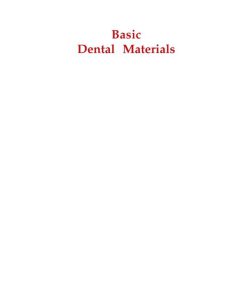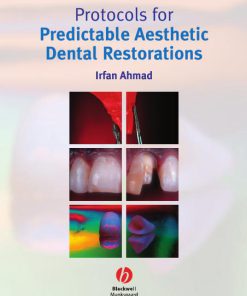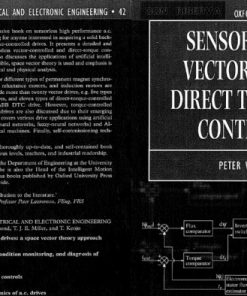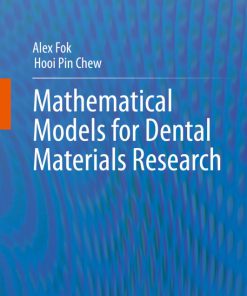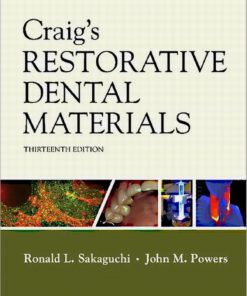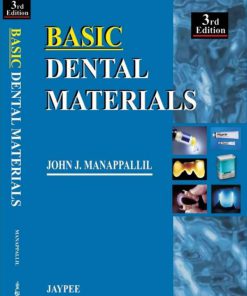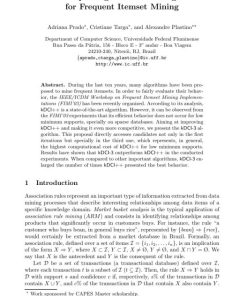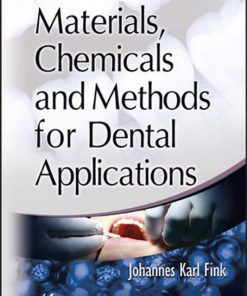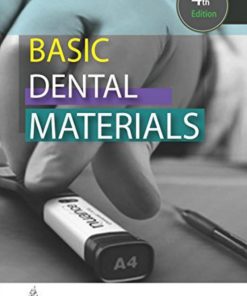Dental Composite Materials for Direct Restorations 1st edition by Vesna Miletic ISBN 3319609602 978-3319609607
$50.00 Original price was: $50.00.$25.00Current price is: $25.00.
Authors:Dental Composite Materials for Direct Restorations-Springer International Publishing (2018) , Author sort:Publishing, Dental Composite Materials for Direct Restorations-Springer International , Published:Published:Nov 2017
Dental Composite Materials for Direct Restorations 1st edition by Vesna Miletic – Ebook PDF Instant Download/Delivery. 3319609602 978-3319609607
Full download Dental Composite Materials for Direct Restorations 1st edition after payment
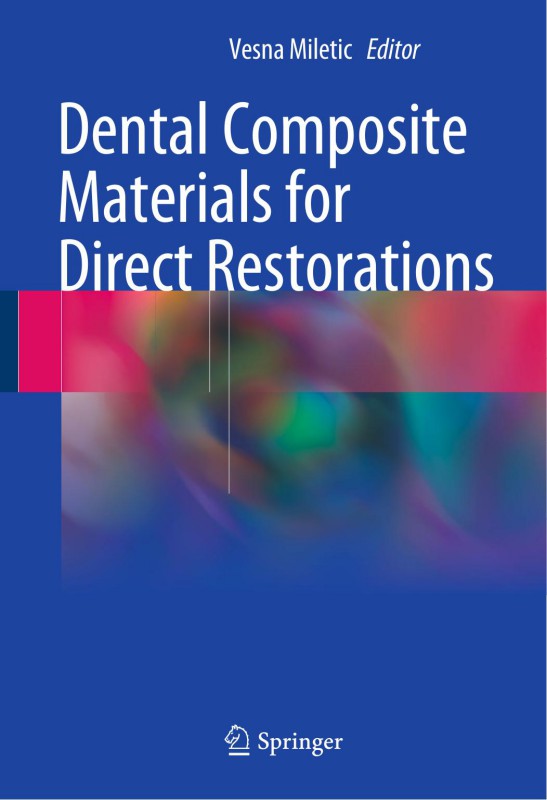
Product details:
ISBN 10: 3319609602
ISBN 13: 978-3319609607
Author: Vesna Miletic
This book covers both basic scientific and clinically relevant aspects of dental composite materials with a view to meeting the needs of researchers and practitioners. Following an introduction on their development, the composition of contemporary composites is analyzed. A chapter on polymerization explains the setting reactions and light sources available for light-cured composites. The quality of monomer-to-polymer conversion is a key factor for material properties. Polymerization shrinkage along with the associated stress remains among the most challenging issues regarding composite restorations. A new classification of dental composites is proposed to offer more clinically relevant ways of differentiating between commercially available materials. A review of specific types of composites provides an insight into their key issues. The potential biological issues of dental composites are reviewed in chapters on elution of leachable substances and cariogenicity of resin monomers. Clinical sections focus on material placement, finishing procedures, and the esthetics and clinical longevity of composite restorations. Bonding to tooth tissues is addressed in a separate chapter, as is the efficiency of various composite repair methods. The final chapter discusses future perspectives on dental composite materials.
Dental Composite Materials for Direct Restorations 1st Table of contents:
Part I: Development and Composition
1: Development of Dental Composites
1.1 Curing Modifications
1.2 Filler Modifications
1.3 Resin Modifications
References
2: Composition of Dental Resin-Based Composites for Direct Restorations
2.1 Monomers
2.2 Initiators in Conventional Photopolymerization
2.3 Fillers
2.3.1 General Description
2.3.2 Optical Properties of Fillers (Visible Light and X-Rays)
2.3.3 Specific Fillers
2.3.3.1 Fibers
2.3.3.2 Clusters
2.3.3.3 “Pre-polymerized” Fillers
2.4 Functional Silane Chemistry
References
Part II: Polymerization
3: Curing Reaction and Kinetics
3.1 Introduction
3.2 Principles of Polymer Chemistry
3.2.1 Types of Polymers and Polymerization Reactions
3.2.1.1 Polymer Structure
Condensation Polymers
Addition Polymers
Condensation Polymers Versus Addition Polymers
3.2.1.2 Polymer Chain Configuration
Linear Polymers
Branched Polymers
Cross-Linked Polymers
3.2.1.3 Polymerization Mechanisms
3.2.2 Kinetics of Radical Chain Polymerizations: Fundamental Aspects
3.2.2.1 Reaction Kinetics (and Its Relationship with Network Development)
Degree of Conversion
Kinetic Chain Length
Chain-Transfer Reactions
Thiol-ene Reactions: Radical-Assisted Step-Growth Polymerization
3.2.3 Factors Influencing the Polymerization
3.2.3.1 Initiators of Polymerization
3.2.3.2 Monomer Structure and Copolymerization
3.2.3.3 Cross-Linking and Cyclization
3.2.3.4 Inhibitor and Catalyst
3.2.3.5 Cure Temperature Versus Glass Transition Temperature
References
4: The Dental Curing Light
4.1 Radiometric Terminology
4.1.1 Radiant Exitance (Irradiance) Vs. Radiant Power
4.1.2 Spectral Radiant Power
4.1.3 Light Beam Uniformity
4.2 Development of Dental Curing Lights
4.2.1 Quartz-Tungsten-Halogen (QTH) Lights
4.2.2 Plasma Arc (PAC) Lights
4.2.3 Argon-Ion Lasers
4.2.4 Light-Emitting Diode (LED) Technology
4.2.5 First-Generation LED Lights
4.2.6 Second-Generation LED Lights
4.2.7 Third-Generation LED Lights: Multi-wave, Multi-peak, and Polywave®
4.2.8 “Turbo” Light Guides
4.2.9 Exposure Reciprocity
4.2.10 High-Output Curing Lights and Stress Development During Polymerization
4.2.11 Soft-Start Exposures
4.2.12 Batteries
4.2.13 Curing Light Output Monitoring
4.3 Practical Considerations for Light Curing Dental Resins in the Mouth
4.3.1 Temperature Considerations
4.3.2 The “Blue Light Hazard”
4.3.3 Light Guide Tip Diameter
4.3.4 Budget Curing Lights
4.3.5 Distance to Target
4.3.6 Ergonomics and Clinical Access
4.3.7 Infection Control
4.3.8 Effect of Training
4.3.9 Choosing a Curing Light
4.3.10 Clinical Recommendations When Using a Curing Light
References
5: Degree of Conversion
5.1 Introduction
5.2 Factors Determining the Degree of Conversion
5.2.1 Intrinsic Factors
5.2.2 Extrinsic Factors
5.2.2.1 Light Sources and Curing Conditions
5.2.2.2 Pre-heating of Composites
5.2.2.3 Post-cure Reaction
5.3 Composite Properties Dependent on the Degree of Conversion
5.3.1 Mechanical Properties
5.3.2 Polymerization Shrinkage and Shrinkage Stress
5.3.3 Biocompatibility
5.3.4 Water Sorption, Solubility, Degradation, and Color Stability
5.4 Methods for the DC Evaluation
5.4.1 Vibrational Spectroscopies: Infrared and Raman
5.4.1.1 Theoretical Background
5.4.1.2 Infrared Spectroscopy
5.4.1.3 Raman Spectroscopy
5.4.1.4 Limitations of the Spectroscopic Techniques
5.4.2 Indirect Methods for the DC Evaluation
5.4.2.1 Microhardness
5.4.2.2 The Depth of Cure (DoC) Concept
5.4.2.3 ISO 4049 Depth of Cure
5.4.2.4 Other Indirect Indicators of Conversion
References
Part III: Classification and New Formulations
6: Developing a More Appropriate Classification System for Modern Resin-Based Composite Technologi
6.1 Current Terminology
6.2 Current Classification Based on Filler Size Distribution
6.3 A Classification Based on Handling Properties
6.4 An Alternative Classification Based on Filler Size Distribution
6.5 Suggestions for New Informative Classifications
6.5.1 Filler Volume Content
6.5.2 Thixotropy and Surface Matting
References
7: Low-Shrinkage Composites
7.1 Introduction
7.2 Low-Shrinkage Strategies in Commercial Composites
7.2.1 High Filler Content
7.2.2 Modified Resin Matrix
7.2.2.1 Replacement of TEGDMA with BisEMA
7.2.2.2 Silorane Chemistry and Filtek Silorane
7.2.2.3 High-Molecular Weight Monomers
7.3 Properties of Commercial Low-Shrinkage Composites
7.3.1 Monomer Conversion
7.3.2 Polymerization Shrinkage and Shrinkage Stress
7.3.3 Mechanical Properties
7.3.4 Sorption and Solubility
7.3.5 Elution
7.3.6 Esthetic Properties
7.4 Clinical Considerations
7.4.1 Marginal Adaptation
7.4.2 Filtek Silorane Adhesive System
7.4.3 Clinical Trials
References
8: Bulk-Fill Composites
8.1 Classification and Composition
8.2 Clinical Evidence
8.3 Laboratory Properties
8.4 Adaptation, Shrinkage Stress, and Handling
References
9: Fiber-Reinforced Composites
9.1 Introduction
9.2 Structure and Properties of FRC
9.2.1 Reinforcing Fibers Used in FRC
9.2.2 Fiber Orientation
9.2.3 Impregnation and Adhesion of Fibers
9.2.4 Fiber Placement and Quantity
9.2.5 Interfacial Adhesion of FRC and Resin Composites
9.3 Applications of FRCs in Dentistry
9.3.1 Prosthodontic Application
9.3.2 Endodontic Application
9.3.3 Tooth Filling and Core-�Buildup Application
9.3.4 Periodontal Splint Application
References
10: Self-Adhering Composites
10.1 Introduction
10.2 A Timeline of the Development and Advances of Self-Adhering Direct Restorative Materials
10.3 Self-Adhering Restorative Materials’ Identity: Components and Interaction with Tooth Subst
10.4 Self-Adhering Flowable Composites: A Prelude of Self-Adhering Composites for Restoration
10.5 Biocompatibility of Self-Adhering Materials
10.6 Bioactive Restoratives
10.7 Self-Adhering Resin Composites: Now and Future
10.8 Final Considerations
References
Part IV: Esthetics of Dental Composites
11: Esthetics of Dental Composites
11.1 Introduction
11.2 Color and Its Dimensions
11.2.1 Hue
11.2.2 Value
11.2.3 Chroma
11.2.4 Translucency
11.3 Color Perception
11.3.1 Illumination
11.3.2 Object (Light Reflection, Light Absorption, and Light Transmittance)
11.3.3 Observer
11.4 Color Selection
11.4.1 Shade Guides
11.4.2 Colorimeters and Spectrophotometers
11.4.3 Digital Cameras and Imaging Systems
11.4.4 Clinical Techniques
11.5 Resin Composite’s Characteristics and Biomimetic of Natural Teeth
11.5.1 Resin Composite Types × Esthetics
11.6 Surface Texture and Gloss
11.6.1 Resin Composite Type × Gloss
11.6.2 Finishing and Polishing × Gloss
11.7 Color Change of Resin Composites
11.7.1 Intrinsic Factors
11.7.2 Extrinsic Factors
11.7.3 Methods to Minimize Discoloration
References
Part V: Biological Considerations
12: Elution of Substances from Dental Composite Materials
12.1 Introduction
12.2 Elution of Monomers from Composite Materials: What Is Eluted?
12.2.1 Elution Rate of Monomers Over Time
12.3 Parameters that Influence the Elution of Monomers
12.3.1 Material Effect on the Elution of Monomers
12.3.2 Effect of Curing Parameters on the Elution of Monomers
12.3.3 Effect of the Storage Medium on the Elution of Monomers
12.3.4 Methods for Analysis of the Eluted Monomers
12.4 Elution of Bisphenol A from Dental Composite Materials
12.5 Elution of Particles from Composite Materials
12.5.1 Methods to Evaluate the Release of Particles from Composite Materials
12.6 Conclusions and Future Perspectives
References
Part VI: Clinical Considerations
13: Bonding to Tooth Tissues
13.1 Current Adhesive Approaches
13.2 Characteristics of the Tooth-Adhesive Bond
13.2.1 Mechanisms of Adhesion
13.2.2 Characteristics of the Hybrid Layer
13.2.3 Polymerization of Adhesive Resin
13.2.4 Clinical Factors Affecting the Adhesive-Dentin Bond
13.3 Characteristics of the Composite-Adhesive Bond
13.4 Mechanisms of Hybrid Layer Degradation
13.4.1 Hydrolytic Degradation of the Resin Matrix
13.4.2 Enzyme-Mediated Collagen Degradation
13.5 Strategies for Improved Durability of Resin-Dentin Bond
13.5.1 Inhibition of Enzyme-Mediated Collagen Degradation
13.5.2 Cross-Linking Agents for Collagen Strengthening
13.5.3 Hydrophobic Hybrid Layers and Improved Polymerization
13.5.4 Therapeutic Remineralization of Resin-Dentin Interfaces
References
14: Polymerization Shrinkage Stress
14.1 Introduction
14.2 Origins of Stress
14.3 Consequences
14.3.1 Consequences Related to the Bonding Area
14.3.2 Cusp Deflection, Tooth Cracking, and Postoperative Sensitivity
14.3.3 What Is the Effect of Stress over the Restoration Longevity?
14.4 Methods for Shrinkage and Stress Evaluation
14.5 Stress Control by Clinical Management
14.5.1 Placement Techniques
14.5.2 Photoactivation Protocols
14.5.3 Stress-Absorbing Layers
14.5.4 Pre-warming Composites
14.6 Stress Development Understanding and Control Related to Material Composition
14.6.1 Model and Experimental Composites
14.6.2 Commercially Available Materials
14.7 Final Thoughts: What Do We Need to Look For?
References
15: Secondary Caries
15.1 Interfacial Gaps and Microleakage
15.1.1 Technique Sensitivity of the Adhesive Procedure
15.1.2 Composite Adaptation into the Cavity
15.1.3 Polymerization Shrinkage
15.1.4 Biodegradation
15.1.5 Mechanical Degradation
15.2 Physicochemical Properties of Composites and Interactions with Dental Plaque
15.2.1 Surface Properties of Composites and Plaque Accumulation
15.2.2 The Release of Composite Compounds Due to Incomplete Polymerization
15.2.3 Lack of Antibacterial Effect of the Material
15.2.4 Lack of Buffering Properties
References
16: Repair of Direct Resin Composite Restorations
16.1 Introduction
16.2 Terminology
16.3 Indications and Contraindications of Repair
16.4 Repair Mechanisms
16.4.1 Surface Roughening by Acid Etching
16.4.2 Surface Roughening by Air Abrasion
16.4.3 Surface Roughening by Bur Cutting
16.4.4 Surface Roughening by Laser
16.4.5 Chemical Bonding
16.5 Effect of Existing Old Resin Composite
16.5.1 Methacrylate-Based Resin Composite
16.5.2 Silorane-Based Resin Composite
16.5.3 Fiber-Reinforced Resin Composite
16.5.4 Dual-Cure Resin Composite
16.6 Clinical Success of Repaired Restorations
16.7 Clinical Recommendations and Conclusion
References
17: Clinical Longevity of Direct Resin Composite Restorations
17.1 What Takes Place in the Mouth?
17.2 Factors Associated with Longevity
17.2.1 Cavity Size, Tooth Position, and Presence of Endodontic Treatment
17.2.2 Restorative Technique
17.2.3 Cavity Lining and Bonding Strategy
17.2.4 Patient’s Risks
17.2.5 Operator
17.2.6 Other Factors
17.3 The Meaning of Clinical Failures
17.3.1 Fractures
17.3.2 Secondary Caries
17.3.3 Esthetics
17.3.4 Differences in Early and Long-Term Failures
17.4 How Long Should We Expect Dental Restorations to Last?
17.4.1 What Is the Best Restorative Resin Composite?
17.4.2 Answered and Unanswered Questions on Longevity
17.5 Concluding Remarks
References
Part VII: Future Perspectives
18: Future Perspectives for Dental Composites
18.1 Introduction
18.2 General Application of Marketed Bioactive Materials in Dentistry
18.3 Past, Present, and Future Bioactive Restoratives
18.4 Concluding Remarks
References
Part VIII: Appendix
19: Clinical Application of Dental Composites for Direct Restorations
19.1 Case 1: Teeth Remodeling Using Direct Resin Composite
19.2 Case 2: Diastema Closure in the Anterior Region
19.3 Case 3: Class I Restoration of a Lower Molar Using a Two-Shade Technique
19.4 Case 4: Class I Restoration of an Upper Molar Using a Three-Shade Technique with Chara
People also search for Dental Composite Materials for Direct Restorations 1st:
latest dental composite materials
dental composite manufacturers
dental composite composition
direct restoration dental examples
direct restorative materials
You may also like…
eBook PDF
Sensorless Vector and Direct Torque Control 1st edition by Peter Vas ISBN 0198564651 978-0198564652
eBook PDF
Craig Restorative Dental Materials 13th Edition by Ronald Sakaguchi 0323081088 978-0323081085




